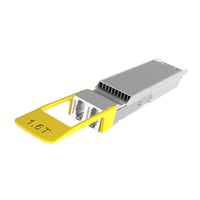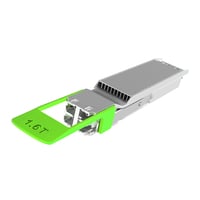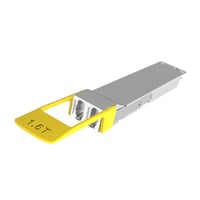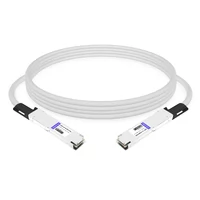An ongoing challenge in data center technologies is the evolution towards more bandwidth and faster data transmission. Organizations are thus introducing advanced optical transceiver modules with 1.6T capabilities, which are efficient boosters for the performance of a data center. This paper touches on the importance of these high-performance modules in the future advancement of data centers and the technical details, benefits, and how they can be implemented. Understanding how 1.6 T optical transceivers work, we try to show how they help achieve better and more reliable data transmission with less latency and more reach. Therefore, it prepares the foundation for the future infrastructure in the digital world.
Table of Contents
ToggleWhat is a 1.6 T Transceiver and How Does it Work?
Key Features of 1.6 T Transceiver Technology
Integrating a 1.6 T transceiver into modern data center infrastructure offers several advanced features that address the escalating demands for speed and efficiency. These modules are engineered to support terabit-level data transmission, making them essential for applications requiring ultra-high bandwidth.
- Ultra-High Data Throughput: A 1.6 T transceiver enables data rates up to 1.6 terabits per second, facilitating seamless handling of large-scale data transfers in cloud computing and AI-driven environments.
- Advanced Modulation Techniques: Utilizing PAM4 modulation, the 1.6 T transceiver optimizes signal integrity over extended distances, reducing errors and enhancing overall network reliability.
- Energy Efficiency: Designed with low-power integrated circuits, these transceivers minimize operational costs while maintaining performance, which is critical for sustainable data center operations.
- Compatibility and Scalability: The 1.6 T transceiver supports backward compatibility with existing fiber optic systems, allowing for phased upgrades without complete infrastructure overhauls.

A 1.6T transceiver is yet another optical module devised to transmit data at a rate reaching up to 1.6 terabits per second (Tbps). It transforms electrical impulses from the network hardware into light impulses and sends them through fiber optic cables, and vice versa. Multiple advanced modulation methods, including pulse amplitude modulation PAM4, tend to be coupled with integrated technologies such as laser and photodetector chips. Such technologies help transmit the data over greater distances with less signal attenuation. This aids in improving the performance and capacity of data centers by widening the data transmission span without spending more resources on them. As a result, 1.6T transceivers can resolve the problem concerning bandwidth and speed growth.
Understanding the Transceiver Module
A 1.6T transceiver module contains several functionalities and components. One of those components is an artificial intelligence-enabled chipset, which includes integrated circuits that are efficient for high signal processing and communication, made possible by lasers. Another crucial component is the photodetectors, which perform the exact opposite process. Through the use of advanced modulation techniques, like PAM4, the transceiver as a whole can maximize transmission rate and, consequently, bandwidth efficiency. Incorporating these advanced technologies into the 1.6 T transceiver module allows for optimal power efficiency and high data throughput coupled with low latency while catering to long-haul data transmission, making it a crucial element of modern high-speed data processing centers.
Exploring the Technology Behind Optical Transceivers
Optical transceivers are indispensable to the contemporary telecommunications infrastructure, enabling data transmission via light with excellent efficacy over short distances. They operate on integrating optical fiber networks and electronics by processing electrical and optical signals with sophisticated optical interfaces. This is further made possible by technologies that include Dense Wavelength Division Multiplexing (DWDM), which boosts capacity by sending more than one signal at different wavelengths over one fiber, and modem technology such as PAM4, which increases information transmission capacity over existing infrastructure. Instead, crucial parts such as integrated lasers for emission signals and photodetectors for reception and conversion are integrated, making it possible to receive and transmit data with high accuracy. These technologies, in aggregate, give data centers the possibility to cope with rising requirements for increasing the speed of data transfer, especially with the use of 400G OSFP solutions.
The Role of PAM4 Modulation in High-Speed Data Transmission
PAM4 modulation, which translates into four distinct levels of pulse amplitude modulation, is significant in high-speed data transmission as larger amounts of information can be fitted inside one signal. In essence, PAM4 achieves a doubling of the data rate as compared to former binary modulation by having four distinct signals instead of two, namely 0 and 1. This, in turn, means bandwidth efficiency can be tremendously improved without needing more physical channel bandwidth. It is beneficial in scenarios such as data centers where the data capacity of 1.6T ESFP modules is an issue. This way, PAM4 modulation better utilizes the available bandwidth and ensures more excellent and faster data transfer because of the increasing requirements for high-speed communication.
What are the Advantages of 1.6 T Transceiver Modules in Data Centers?
Applications of 1.6 T Transceiver in Modern Industries
The versatility of the 1.6 T transceiver extends beyond traditional data centers, finding applications in various sectors where high-speed connectivity is paramount. This technology is particularly suited for environments demanding low latency and high capacity.
- Hyperscale Data Centers: In large-scale facilities, the 1.6 T transceiver supports massive data aggregation for services like video streaming and real-time analytics, ensuring uninterrupted performance.
- Telecommunications Networks: Telecom providers utilize 1.6 T transceiver modules to expand 5G and beyond infrastructures, enabling faster mobile broadband and edge computing.
- AI and Machine Learning Workloads: For AI training clusters, the 1.6 T transceiver accelerates data interchange between servers, reducing processing times and improving model accuracy.
- Enterprise Networking: Businesses adopt 1.6 T transceiver solutions for internal high-bandwidth needs, such as virtual reality simulations and big data processing.

Enhancing Bandwidth and Data Rate Capabilities
1.6 T transceiver modules use bandwidth and possible rate better using newer optical technologies, making transmission more dense and data-rich. The advanced modules provide an effective solution for large amounts of data transfer, thus satisfying the scale requirements in contemporary data hubs. They are purpose-built for increased data volume and port densities to optimize the use of existing facilities without necessarily requiring more real estate. In addition, the 1.6 T transceivers support high bit rates of data transmission by employing complex modulation and multiplexing techniques that enable the transmission of a more significant amount of data at a time. It leads to a decrease in transmission time and improved quality of service of the entire network and, therefore, is the cornerstone for the growing realization of future data center structure and operational trends.
Reducing Power Consumption and Optimizing Efficiency
1.6 T transceiver modules make plausible energy savings and augment efficiency by integrating novel ideas to enhance energy usage efficiency. Silicon photonics and co-packaged optics are incorporated to decrease energy consumption on a bit basis, which is a significant aspect for mega data centers where activities run throughout the day. Power management techniques, including intelligent control over power and thermal optimization, are also helpful. Such innovations improve the ecological footprint of the data centers while economically making sense in lowering energy costs requisite for high-density interfaces. As a critical element in the broader sustainable and high-quality performance area, 1.6 T transceivers help achieve sustainable cases overall.
Supporting High-Performance Data Center Networks
1.6 T transceivers are a prerequisite for dense data center networks since they efficiently manage the increased need for information. Because of better bandwidth, a greater amount of data can be transferred through the network with these transceivers. They support more complex network topologies, including spine-leaf ones, which enhance scalability and improve low latency. In addition, these transceivers are integrated with the current systems and can be easily upgraded with little reconstruction effort. This compatibility allows data centers to increase network resources and meet load requirements without losing efficiency.
How Does the 1.6 T OSFP-XD Improve Network Infrastructure?

Comparing OSFP and OSFP-XD Form Factors
The OSFP (Octal Small Form Factor Pluggable) and OSFP-XD (Extra Density) are new form factors focused on improving the network infrastructure’s performance and efficiency. A standard OSFP is designed to maintain high-density provision of up to 800Gbps per connector module for several use cases, including operating at the data center level. At the same time, the evolution of this standard for the data center application, or simply say it’s a revolution in the designing of ports, OSFP-XD MSA, can now take data transmission to over 1.6 Terabits per module. The enhanced bandwidth comes from adding more lanes while retaining the exact physical dimensions, thus allowing for more excellent coverage without additional space. Both of the above form factors are backward compatible for system integration, but in terms of the future networks that data centers focus on, meeting the demand for data will never be a problem with OSFP-XD.
Advantages of the OSFP MSA in Optical Communication
The OSFP MSA (Multi-Sourced Agreement) offers broad benefits in optical communication through the genericization of the design of transceivers capable of working with high speed. To start with, the OSFP form factor is very much known for being a high-density solution, which results in a lot of bandwidth being available within a pocket-sized volume, a factor that is essential in today’s modern data centers, which are running out of space. In addition, its capability to handle 400Gbps to as much as 800Gbps also makes it cost-effective in scaling up the network infrastructure without having to change a lot of hardware. Furthermore, the backward compatibility coupled with the thermal performance characteristics guarantees that these modules do not impede but rather facilitate a smooth integration into the existing infrastructures; thus, no disruption is likely to occur during network upgrades. These attributes render the OSFP MSA suitable for use in data-crowded centers wishing to boost performance without restrictions on flexibility or future expansion limits.
Integrating 800G OSFP and Higher in Network Systems
The integration of OFSP and the above modules within network systems commences with reviewing the existing infrastructure to guarantee compatibility and readiness for higher data throughput. The modules would require data rates of up to 800 Gbps per module and an effective sewing layer to transmit large volumes of data via the QSFP28 interfaces. It is advisable to introduce these modules through stages, starting with the key applications and site integration changes in performance level and adaptations within the existing system. It is imperative that the switching thermal management systems be robust enough to cater to the higher power requirements of the system without compromising on reliability. Finally, using vendors with extensible modules and strong management and support tools will ease the deployment of these advanced modules while enabling the future growth of the network system.
What are the Key Features of the 800G Optical Modules?
Future Trends and Innovations in 1.6 T Transceiver Development
As data demands continue to surge, the evolution of 1.6 T transceiver technology is poised to incorporate emerging innovations that further enhance performance and adaptability. Industry experts anticipate several key trends that will shape the next generation of these modules.
- Integration with Silicon Photonics: Future 1.6 T transceiver designs may increasingly rely on silicon photonics to reduce manufacturing costs and improve signal processing speeds.
- Enhanced DWDM Capabilities: Advancements in Dense Wavelength Division Multiplexing (DWDM) will allow 1.6 T transceivers to multiplex more channels over a single fiber, boosting overall network capacity.
- Sustainability Focus: With a push towards greener technologies, upcoming 1.6 T transceiver models are expected to feature even lower power consumption and recyclable materials.
- AI-Optimized Chipsets: Incorporating AI-driven error correction and adaptive modulation will make 1.6 T transceivers more intelligent, automatically optimizing for varying network conditions.
These trends underscore the long-term potential of 1.6 T transceiver technology in supporting the digital economy’s growth. Staying informed about these developments can help organizations plan strategic investments.

The Importance of SMF in Optical Transmission
While researching the importance of single-mode fiber (SMF), I discovered that it is essential for efficient high-speed data transfer over long distances. One of the critical benefits of SMF is the capability to transmit and receive long-distance communication with higher bandwidth and minimal signal degradation, which is advantageous for use in telecom and data centers. Single-mode fibers attach less modal dispersion when compared to multimode fibers, which allows more data to be sent using a clearer signal. This ability significantly improves the performance of the network. It is essential to properly introduce advanced optical modules, such as those operating at 800G, to ensure that they operate at peak efficiencies and scale to meet future requirements.
The Impact of Wavelength and Lambda Technologies
Wavelength and lambda technologies influence optical networks by determining the light frequency used for data transfer. WDM is the technology that allocates different wavelengths to different channels to maximize bandwidth. This means that many signals can be transmitted over a single fiber optic cable because of this configuration, increasing the quantity of information that the fiber cable can carry. Lambda’s technologies enable the efficient orchestration of these wavelengths, optimizing network performance and scalability. As networks grow and the demand for information rises, wavelength and lambda technologies are crucial in developing a robust and adaptive communication infrastructure.
Exploring Fiber Optic Cable Compatibility
Integration and smooth functioning of optic systems depend on several factors. For instance, network specifications, such as whether the fiber is single-mode or multimode, should be complied with to secure the performance metrics and distance range. Additionally, there is a need to integrate optical transceivers and connectors with the appropriate fiber type to minimize signal loss. Also, wavelength compatibility should be confirmed; high-frequency transmission should be applied when a specific band is most suitable for the application and vice versa. Network assessment must, therefore, take care of these factors, including adopting 100G and 200G technologies to achieve the desired network performance levels and the desired geometric distribution of the elements of fiber optic technology.
How to Implement and Manage 1.6 T Transceiver Solutions?

Planning for Data Center Network Upgrades
A few steps must be followed when achieving network integration utilizing a 1.6 T transceiver. Begin by assessing the current bottlenecks in infrastructure and how they can be improved and Overhauled. They evaluate the network’s capabilities to ensure that the high-volume transceivers are not out of bounds. Implement placing the QSFP112 transceivers such that the free space constraint has a modular approach with shields employed to allow for soft switching and maintain connectivity throughout. Achieve such by using a network management system enabling seamless infrastructure management to scale and secure the data center. Moreover, it concerns energy efficiency and thermal management to develop a reliable system while adhering to growing power usage. Following these principles leaves an opportunity for excellent optimization in performance as the scale and demand for data owing to the expansion of the internet are ever-increasing.
Ensuring Compatibility with Existing Infrastructure
During the transition to the 1.6 T transceiver solutions, it is relevant to conduct integrity checks of network components and configuration before integrating them to check whether the end infrastructure is congruent with the new solution implemented. To begin with, it is essential to install new transceivers that meet the current cabling provisions, such as the sort of cutting-edge hybrid optical fiber and connectors, to avoid signal loss. Also, considering that power and thermal requirements may differ, check that existing power systems can cope with increased requirements. Consider the power required for device activation and re-evaluate policies to establish efficient data flow, such as the 400G OSFP standard. Lastly, it is wise to cooperate with white-label manufacturers or suppliers so that the integration process goes smoothly and follows the industry’s new findings on how to conform in the future.
Monitoring Optical Networks for Optimal Performance
To accomplish the best possible outcomes for optical networks, a systematic strategy for surveillance supported by modern tools and techniques should be developed. Installation of such applications might facilitate localization of errors, estimation of fiber loss, and installation requirements to ensure signals do not deteriorate. Moreover, from the point of view of management, practical steps should be taken that involve using a performance monitoring system that provides real-time information on parameters that matter, such as latency, jitter, and error rate, which directly affect the quality of service. Automated monitoring is beneficial in quickly identifying and correcting any such abnormalities and thus achieving the desired control of the network. Incorporating such advanced monitoring tools and techniques allows the management to provide the expected level of reliability and efficiency in the optical network infrastructure.
Reference Sources
Frequently Asked Questions (FAQs)
Q: Please explain the 1.6 T optical transceiver module by comparing it with the 400G module.
A: 1.6 T optical transceiver module is an interconnecting device designed to transfer data at a speed of 1.6T. This device is specially made for use in hyperscale data centers. It is to be noted that the 400G optical modules were designed only to transfer data at a total of 400gillion. There have been technological advancements, and 1.6t was made possible by using optical engines and coherent fiber transmission. Because of these changes, the American country is expected to save considerable power while also increasing profits due to the competition.
Q: What are the advantages of using 1.6T OSFP-XD transceivers in data centers?
A: 1.6T OSFP-XD transceivers have benefits such as forward compatibility and are designed to be integrated with the current QSFP112 interfaces, which support sizing, increasing bandwidth by 1. These transceivers also mitigate the cost challenges by providing high port density with significant energy and cost-saving technology while also being able to transmit over longer distances. These factors will help revolutionize the current standards of data centers by enhancing the world’s scale.
Q: What advantages do 1.6T optical modules have as opposed to 400G QSFP-DD and OSFP transceivers?
A: 1.6T optical modules have enormous technological advances over 400G modules. First, as mentioned, 1.6T modules have four times more bandwidths, up to 1600 gigabits. Second, 1.6T modules have low power consumption and the capability of longer distances, which is very useful for high-speed networks in data centers.
Q: 1.6T Optical transceiver modules: can they support breakout configuration?
A: Yes, 1.6T optical transceiver modules can support breakout configurations. This allows for more versatile configurations, such as breaking out a single 1.6T port into several lower-speed ports (for example, a 4x400G or 8x200G configuration). With such capabilities, data center operators will be able to use their resources and network architecture more efficiently.
Q: What fibers would work with the 1.6T optical transceiver modules?
A: By definition, and based on the nature of the environment, the 1.6T optical transceiver modules, which include 1.6T OSFP, are expected to be in use alongside the preexisting data center cables. In most cases, they are compatible with the standard single-mode fiber cables and SMF transceivers, mainly used globally for high-speed, long-distance transmission links. Specific 1.6T modules for MMF can only be less than 100m for particular purposes; design and application requirements are the determinants.
Q: What role do the 1.6T optical modules play in the transition from 400G to 800G and more in the circuits of data centers?
A: The evolution of the data centers from the 400 G networks to the 800G networks and their offspring will feature the 1.6T optical modules as vital components at every stage. They act as the bridge or gap fillers by increasing bandwidth and improving efficiency. These modules allow data centers to satisfy the current bandwidth requirement, such as 200g and 400g, with an upgrade in the future. One of the roles that the technology incorporated in 1.6T modules plays is the development of greater optical interconnects, enabling faster optical links in future interconnections of data centers.
Q: What is the usual scope coverage for the 1.6T Optical Transceiver Modules?
A: Several factors, including the module’s design parameters and the types of fibers used, affect the distance at which the transmission can take place. However, many 1.6T modules can support distances up to 2 km or more on single-mode fiber. This makes them suitable for intra-data center connections and links between nearby data center facilities, providing network design and expansion flexibility.
Related Products:
-
 NVIDIA MMS4A00 (980-9IAH1-00XM00) Compatible 1.6T OSFP DR8D PAM4 1311nm 500m IHS/Finned Top Dual MPO-12 SMF Optical Transceiver Module
$2600.00
NVIDIA MMS4A00 (980-9IAH1-00XM00) Compatible 1.6T OSFP DR8D PAM4 1311nm 500m IHS/Finned Top Dual MPO-12 SMF Optical Transceiver Module
$2600.00
-
 NVIDIA Compatible 1.6T 2xFR4/FR8 OSFP224 PAM4 1310nm 2km IHS/Finned Top Dual Duplex LC SMF Optical Transceiver Module
$3100.00
NVIDIA Compatible 1.6T 2xFR4/FR8 OSFP224 PAM4 1310nm 2km IHS/Finned Top Dual Duplex LC SMF Optical Transceiver Module
$3100.00
-
 NVIDIA MMS4A00 (980-9IAH0-00XM00) Compatible 1.6T 2xDR4/DR8 OSFP224 PAM4 1311nm 500m RHS/Flat Top Dual MPO-12/APC InfiniBand XDR SMF Optical Transceiver Module
$3600.00
NVIDIA MMS4A00 (980-9IAH0-00XM00) Compatible 1.6T 2xDR4/DR8 OSFP224 PAM4 1311nm 500m RHS/Flat Top Dual MPO-12/APC InfiniBand XDR SMF Optical Transceiver Module
$3600.00
-
 0.5m (1.6ft) NVIDIA Compatible 1.6T OSFP-RHS to OSFP-RHS Passive Direct Attached Cable
$465.00
0.5m (1.6ft) NVIDIA Compatible 1.6T OSFP-RHS to OSFP-RHS Passive Direct Attached Cable
$465.00




